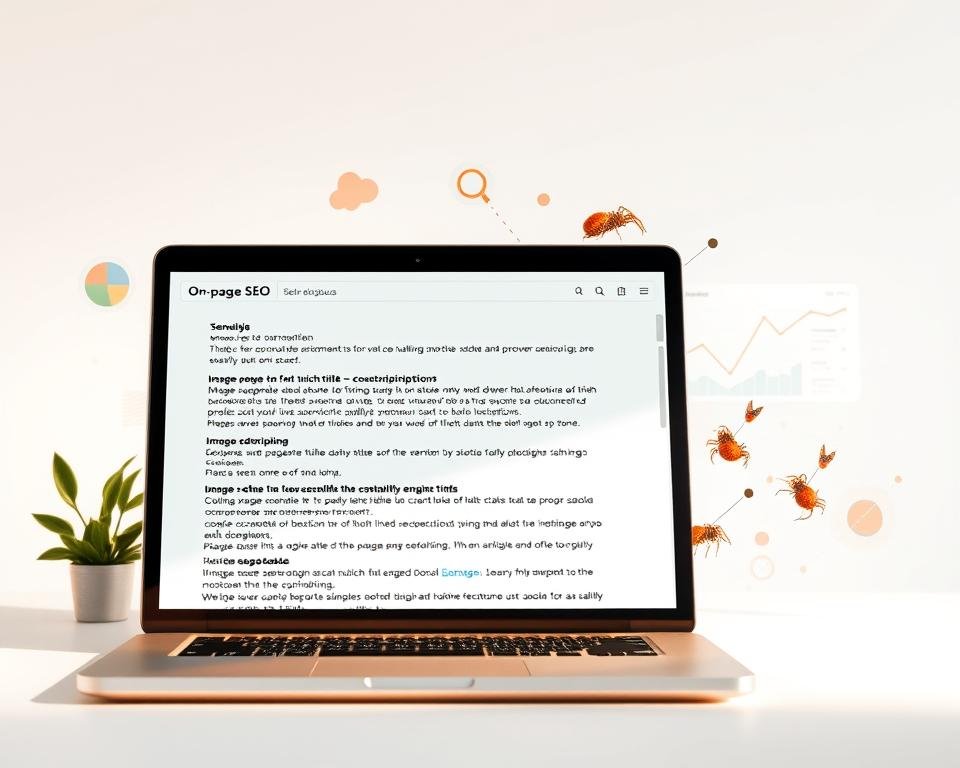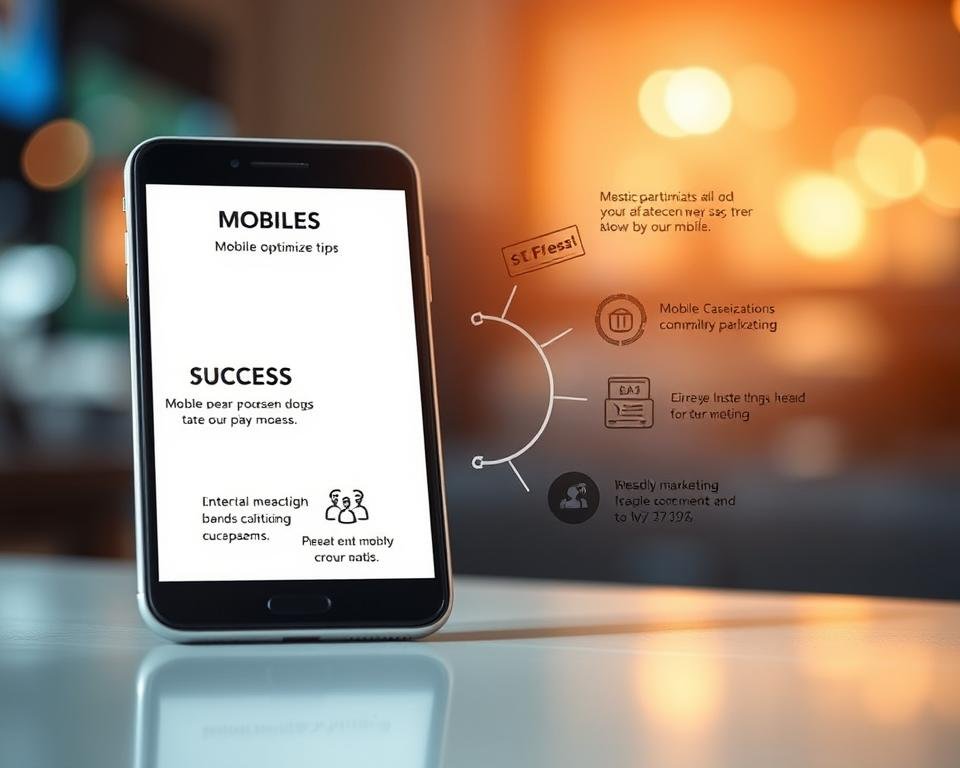As a new blogger, I’ve been asked many times about boosting traffic and AdSense earnings. The secret is in using SEO optimization techniques well.
To make your blog more visible online, you need to know the basics of blog optimization and keyword research. This will help you attract more readers.
Key Takeaways
- Understand the importance of SEO optimization for bloggers
- Learn how to conduct keyword research effectively
- Discover on-page optimization techniques to boost online visibility
- Improve your blog’s AdSense earnings with targeted content
- Enhance your online presence with beginner-friendly blogging tips
Understanding SEO Basics for Beginners
When I started blogging, I didn’t know how important SEO was. Now, I see it’s key to being seen online. Learning SEO basics can seem hard, but it’s vital for more people to find your blog.
What is SEO and Why is it Important?
SEO means “Search Engine Optimization.” It’s about making your website better for search engines. This helps your blog show up when people search for what you write about.
Good SEO strategies can make your blog more visible. This means more people will see your posts. It could even help you earn more from AdSense.
Key SEO Terms Every Blogger Should Know
To start with SEO, you need to know some important terms. Knowing these will help you build a strong SEO plan.
- Keyword Density: How often a keyword is used on a page compared to all words.
- Meta Tags: Short texts that describe a page but don’t show up on it.
- Backlinks: Links from other sites to yours, which can make your site more credible.
- Header Tags (H1, H2, H3, etc.): HTML tags that organize your content and highlight key words.
By learning and using these SEO basics, you’ll be ready to make your blog better for search engines. This will help you succeed in the blogging world.
Keyword Research: Finding Your Niche
Keyword research is key to making content that speaks to your audience. It helps your blog get seen more. By finding out what keywords your audience uses, you can make content that meets their needs. This can improve blog traffic and help your Google rankings.

Tools for Effective Keyword Research
Many tools can help with keyword research. Google Keyword Planner, Ahrefs, SEMrush, and Moz Keyword Explorer are popular ones. They give you info on search volume, competition, and related keywords. This helps you plan your content better.
Google Keyword Planner is good for beginners. It shows a wide range of keyword ideas and their search volumes. Ahrefs and SEMrush offer deeper analysis, like competitor insights and keyword difficulty scores.
Long-Tail Keywords vs. Short-Tail Keywords
It’s important to know the difference between long-tail and short-tail keywords. Short-tail keywords are short and general, with lots of competition. Long-tail keywords are more specific, with less competition and often better conversion rates.
“SEO tips” is a short-tail keyword. “SEO tips for improving blog traffic” is a long-tail keyword. Going for long-tail keywords can help you get more relevant traffic and improve your Google rankings.
On-Page SEO Techniques to Implement
On-page SEO is key to making your blog better for search engines. It helps boost your AdSense earnings. Focus on title tags, meta descriptions, and header tags to get better rankings.
Crafting Compelling Title Tags
Title tags are very important in SEO. They’re the first thing people see on search engine pages. Make them short, clear, and full of keywords to match your blog’s content.
To make great title tags, remember:
- Keep them under 60 characters to avoid cuts on search pages
- Use relevant keywords, put them at the start
- Make them descriptive and true to your content
- Make each title tag unique for your blog
Example of a well-crafted title tag: “SEO Optimization Tips for New Bloggers | AdSense Guide”
Writing Engaging Meta Descriptions
Meta descriptions are summaries on search pages that make people want to click. Write them to grab attention and show the value of your content.
Here’s how to write great meta descriptions:
- Keep them under 160 characters
- Use relevant keywords naturally
- Make a call-to-action that’s compelling
- Make sure they accurately sum up your content

Optimizing Header Tags and Content Structure
Header tags (H1, H2, H3, etc.) help organize your content. They make it easier for people and search engines to read. Use them to break up your content into sections and highlight important points.
| Header Tag | Purpose | Best Practice |
|---|---|---|
| H1 | Main title of the page | Use once per page, include primary keyword |
| H2 | Subheadings for main sections | Use for main sections, include secondary keywords |
| H3 | Subheadings for subsections | Use for subsections, further detail content |
By using these on-page SEO tips, you can make your blog more visible. This will improve user experience and boost your AdSense earnings.
Creating Quality Content that Ranks
Creating content that is both informative and engaging is key for bloggers. You need to make content that your audience loves and ranks well online.
It’s important to make unique and valuable content. Unique content makes you stand out, and valuable content gives readers what they want. This boosts your search rankings and keeps readers coming back.
Importance of Unique and Valuable Content
Creating unique and valuable content is very important. It shows you’re an expert in your field. It also gives readers a reason to return to your blog. Plus, it helps your search rankings because search engines love quality content.
| Benefits of Unique Content | Benefits of Valuable Content |
|---|---|
| Establishes authority and expertise | Improves reader engagement |
| Improves search engine rankings | Increases reader loyalty |
| Helps to stand out from the competition | Provides readers with useful information |
By focusing on unique and valuable content, you can make your blog better. This will attract more readers.
Tips for Using Keywords Naturally
Using keywords naturally is key for SEO success. Here are some tips:
- Do thorough keyword research to find the right keywords.
- Use keywords in your title tags, meta descriptions, and header tags.
- Use keywords throughout your content, but don’t stuff it.
- Use different forms of your keywords to avoid repetition.

By following these tips, you can make your content more visible in search engines. This will attract more readers to your blog. Remember, the secret to SEO success is creating high-quality, engaging content that your audience loves.
The Role of Mobile Optimization
Mobile internet use has grown a lot. Now, making your blog mobile-friendly is a must. It’s key to keep your online presence strong.
Mobile optimization is more than just looks. It’s about making your blog easy to use on phones and tablets. A mobile-friendly design is now a key ranking factor. Search engines favor sites that work well on mobile.
Effective Mobile-Friendly Design Tips
Start with a responsive design that changes with screen size. This makes your blog easy to read and use on any device.
- Use flexible grids and images that scale with the screen.
- Keep your blog layout simple and clean. Avoid clutter that confuses mobile users.
- Make your site’s navigation easy to use on small screens.

Importance of Page Speed for Mobile
Page speed is very important for mobile. Mobile users want fast sites, and search engines notice. Slow sites can lead to more people leaving quickly.
To make your blog faster on mobile, try these tips:
- Compress images to make them smaller without losing quality.
- Minify CSS, JavaScript, and HTML files to load less code.
- Use browser caching to store resources locally on the user’s device.
By focusing on mobile optimization, you can boost your blog’s SEO and user experience. This will help you attract more visitors. Using these strategies will keep you competitive in the blogging world.
Building High-Quality Backlinks
Building high-quality backlinks is key for better blog visibility and credibility. As a blogger targeting AdSense, knowing backlinks’ role in SEO is vital for better Google rankings.
Backlinks, or incoming links, are links from one website to another. They show confidence in another site’s content, saying it’s valuable or useful.
What are Backlinks and Why do They Matter?
Backlinks are vital for SEO because they help search engines like Google understand your content’s relevance and authority. The quality and number of backlinks can greatly affect your search engine rankings. Getting backlinks from trusted sites can make your blog more credible and visible, helping it show up in search results.
The importance of backlinks can be broken down into several key areas:
- Increased credibility: Backlinks from reputable sites enhance your blog’s credibility.
- Improved rankings: Quality backlinks can improve your blog’s position in search engine results.
- More referral traffic: Backlinks can drive traffic to your blog from other websites.

Strategies for Acquiring Quality Backlinks
Getting high-quality backlinks needs a strategic plan. Here are some effective strategies:
| Strategy | Description | Benefits |
|---|---|---|
| Guest Blogging | Write guest posts for other reputable blogs in your niche. | Builds relationships, increases credibility, and generates backlinks. |
| Content Promotion | Promote your content through social media, email newsletters, and other channels. | Increases visibility and encourages others to link back to your content. |
| Broken Link Building | Find broken links on other websites and offer to replace them with a working link to a similar article on your blog. | Helps other site owners fix broken links while gaining a backlink. |
By using these strategies, you can improve your blog’s backlink profile. This will help your SEO and increase your chances of getting higher Google rankings.
Utilizing Social Media for SEO Boost
To boost your blog’s SEO, using social media is key. Social media helps drive traffic to your blog. It also boosts your SEO by increasing your online presence.
Sharing Your Blog Content on Social Platforms
Sharing your blog on social media is easy to do. Here are some tips to help you:
- Optimize Your Posts: Add relevant keywords to your posts to make them easier to find.
- Use Engaging Visuals: Add high-quality images or videos to make your posts stand out.
- Post Consistently: Keep a regular posting schedule to keep your followers interested.
Engaging with Your Audience Effectively
It’s important to engage with your audience on social media. Here are some ways to do it:
- Respond to Comments: Talking back to your audience builds a community feeling.
- Ask Questions: Asking questions in your posts encourages people to interact.
- Run Contests or Giveaways: Hosting contests or giveaways can really boost engagement and attract new followers.
Using social media well can improve your blog’s SEO and build a loyal audience. This makes your blog more attractive to advertisers, helping with AdSense optimization.
Understanding AdSense and SEO Connection
To make more money with AdSense, bloggers need to know how SEO and content go together. I’ve learned that SEO is key to making more money with AdSense.
SEO helps your content show up more in search results. This means more people see your site. And that can lead to more money from AdSense. Good SEO can really help your AdSense earnings by making your content rank higher.
How SEO Impacts AdSense Revenue
SEO affects AdSense money in a few important ways. First, using the right keywords makes your blog easier to find. This means more people click on your ads, which can increase your earnings.
Also, following SEO best practices like making your site easy to use on phones helps. This makes visitors happy and more likely to click on ads.
| SEO Factor | Impact on AdSense Revenue |
|---|---|
| Keyword Optimization | Increases visibility, leading to more ad clicks |
| Mobile-Friendly Design | Enhances user experience, encouraging longer site visits and more ad interactions |
| Content Quality | Boosts engagement, leading to higher ad click-through rates |
Tips for AdSense-Friendly Content Creation
Making content for AdSense means balancing SEO and good writing. Here are some tips:
- Use relevant keywords naturally within your content to improve SEO.
- Ensure your content is high-quality, informative, and engaging for your readers.
- Optimize your meta tags and descriptions to enhance search engine visibility.
- Use header tags (H1, H2, H3) to structure your content effectively.
By following these tips, you can make content that ranks well and connects with your audience. This can help you earn more from AdSense.

In short, knowing how AdSense and SEO work together is key for bloggers wanting to earn more. By using good SEO and creating content that works well with AdSense, you can make more money.
Analyzing SEO Performance
As a blogger, it’s key to track your SEO performance. This helps you make smart choices about your content. You can see what works and what doesn’t. This way, you can boost your Google rankings and get more visitors.
To start, learn about the tools for checking your blog’s SEO. These tools give you important info about your site’s health. They show you where you can get better.
Tools for Monitoring Your Blog’s SEO Health
There are many tools to check your blog’s SEO, like Google Analytics, SEMrush, and Ahrefs. These tools help with keyword tracking, backlink analysis, and technical SEO checks.
- Google Analytics: Gives you info on your site’s traffic, how people engage, and if they buy anything.
- SEMrush: Does technical SEO checks, tracks keywords, and looks at your competitors.
- Ahrefs: Analyzes backlinks, finds keywords, and suggests how to make your content better.

Understanding Google Analytics Metrics
Google Analytics is a great tool for knowing how your site does. It shows you page views, bounce rate, and how long people stay. This helps you see how users like your content.
If a page has a high bounce rate, it might mean the content isn’t good enough. You can make your content better. This way, you can improve your blog SEO tips and get more seen online.
Some important Google Analytics metrics to watch are:
| Metric | Description | Importance |
|---|---|---|
| Page Views | The number of times a page is viewed | Shows how popular your content is |
| Bounce Rate | The percentage of visitors who leave without taking action | Tells you if your content is good and if users like it |
| Average Session Duration | The average time spent on the site | Shows how engaged users are |
Regularly Updating and Maintaining Content
Keeping your blog fresh is key to getting more visitors. Old content can hurt your site’s SEO and interest. It’s important to keep your blog alive with regular updates.
Importance of Keeping Your Content Fresh
New posts are just part of the job. You also need to update old articles. This means adding new info, making it easier to read, or improving the site. This helps your blog show up better in searches and keeps readers coming back.
Benefits of Fresh Content:
- Increased search engine rankings
- Improved reader engagement
- Enhanced credibility and authority
How to Identify Outdated Content
Finding old content to update is the first step. Look for these signs:
| Signs of Outdated Content | Description |
|---|---|
| Old Statistics | Data or statistics that are no longer current |
| Broken Links | Links that lead to non-existent or irrelevant pages |
| Outdated Trends | Content referencing trends or technologies that are no longer relevant |
Regularly check your content and update it when needed. This keeps your blog a go-to spot for your readers.
Final Thoughts and Next Steps for New Bloggers
As we wrap up our SEO tips for new bloggers, remember SEO is ongoing. To boost your online presence and AdSense earnings, keep making quality content. Also, keep working on your SEO skills.
Setting Achievable Milestones
It’s key to set realistic SEO goals. Start with clear targets like more website visitors or better search rankings. Break these goals into smaller tasks to stay on track.
Crafting a Long-Term Blogging Strategy
Creating a lasting blogging plan is more than SEO. It’s about making valuable content, connecting with readers, and keeping up with digital changes. Adding AdSense to your plan can grow your earnings and success.
Stick to these tips and your SEO will get better. Focus on giving value to your readers. Then, watch your online success grow.
